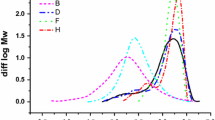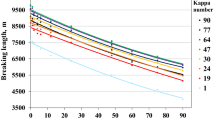Abstract
Degradation of cellulose under alkaline conditions is involved either involuntarily or deliberately in many different cellulose processing steps, such as pulping, bleaching, or aging within the viscose process, and the underlying chemistry has been the topic of numerous studies. When it comes to aging under alkaline conditions—either natural or accelerated (artificial)—the degradation processes are by far less investigated and understood. A prominent example of moderately alkaline cellulosic material is deacidified book paper from libraries which had undergone a mass-deacidification treatment. We studied their aging behavior under accelerated conditions in comparison to non-deacidified duplicates in order to better understand how the alkaline reserve, which was introduced by the deacidification treatment, affects the stability of the books on the long run. GPC analysis of cellulose and determination of carbonyl functionalities were performed, which were critical parameters to achieve a deeper insight into hydrolytic and oxidative changes of cellulose structure upon deacidification treatment and subsequent aging. Also, model book papers impregnated with different amounts of alkaline reserve were used to support the findings from the original book samples. Hydrolytic degradation rates of the original book papers were significantly reduced after mass deacidification compared to the non-deacidified duplicates. The beneficial effect of mass deacidification on cellulose stability was found to be strongly related to the amount of alkaline reserve deposited, independent of varying parameters of book papers. Although some indication of alkali-induced β-elimination was found (a minor decrease of the along-chain carbonyl content in the original deacidified book papers during aging), it did not occur to an extent that significantly influenced the molar mass of cellulose. The beneficial effect of retarded hydrolytic degradation by mass deacidification thus clearly outweighed possible negative alkalinity effects of the deposited alkaline reserve.








Similar content being viewed by others
References
Ahn K, Henniges U, Blüher A, Banik G, Potthast A (2011) Sustainability of mass-deacidification—Part I: concept, selection of sample books, and pH-determination. Restaurator 32:193–222
Ahn K, Banik G, Potthast A (2012a) Sustainability of mass-deacidification—Part 2: evaluation of alkaline reserve. Restaurator 33:47–75
Ahn K, Henniges U, Banik G, Potthast A (2012b) Is cellulose degradation due to β-elimination processes a threat in mass deacidification of library books? Cellulose 19:1149–1159
Andres H, Blüher A, Grossenbacher G, Reist M, Vogelsanger B, Wälchli M (2008) The papersave swiss-process. Quality control and efficacy. Restaurator 28:3–28
Arney JS, Jacobs AJ, Newman R (1979) The influence of deacidification on the deterioration of paper. JAIC 19:34–41
Banik G (2005) Mass deacidification technology in Germany and its quality control. Restaurator 26:63–75
Baty JW, Maitland CL, Minter W, Hubber MA, Jordan-Mowery SK (2010) Deacidification for the conservation and preservation of paper-based works: a review. BioResources 5:1955–2023
Begin PL, Kaminska E (2002) Thermal accelerated aging test method development. Restaurator 23:89–105
Blüher A, Vogelsanger B (2001) Mass deacidification of paper. Chimia 55:981–989
Bogaard J, Whitmore PM (2001) Effects of dilute calcium washing treatments on paper. JAIC 40:105–123
Bohrn R, Potthast A, Schiehser S, Rosenau T, Sixta H, Kosma P (2006) The FDAM method: determination of carboxyl profiles in cellulosic materials by combining group-selective fluorescence labelling with GPC. Biomacromolecules 7:1743–1750
Ding HZ, Wang ZD (2008a) On the degradation evolution equations of cellulose. Cellulose 15:205–224
Ding HZ, Wang ZD (2008b) Author response to the comments by P. Calvini regarding the article ‘‘on the degradation evolution equations of cellulose’’ by H.-Z. Ding and Z. D. Wang. Cellulose 15:229–237
Doering T (2007) Altes Papier-Neue Techniken; Zerstörungsfreie Untersuchungen von Papier mit Festphasenmikroextraktion (SPME). BWV-Berliner-Wissenschafts-Verlag, Berlin, p 153
Entwistle D, Cole EH, Wooding NS (1949) The autoxidation of alkali cellulose Part 1: an experimental study of the kinetics of the reaction. Textile Res. J. 19:527–546
Fellers RL, Lee SB, Bogaard J (1986) The kinetics of cellulose deterioration. In: Needles HL, Zeronian SH (eds) Historic texteile and paper materials: conservation and characterization. American Chemical Society, Washington, DC, pp 329–346
Fengel D, Wegener G (1984) Wood chemistry, ultrastructure, reaction. Walter de Gruyter, Berlin/New York, pp 296–300
Gerlach A (2006) Paper deacidification and quality control at the central and regional library Berlin. In: Blüher A, Grossenbacher G (eds) Save paper! Mass deacidification—today’s experience—tomorrow’s perspectives. Bern, Swiss National Library, pp 21–36
Grossenbacher G (2006) Paper deacidification as a measure for preserving originals. In: Blüher A, Grossenbacher G (eds) Save paper! Mass deacidification—today’s experience—tomorrow’s perspectives. Bern, Swiss National Library, pp 7–20
Hanson FS (1939) Resistance of paper to natural ageing. Pap Ind Pap World 20:1157–1163
Henniges U, Schiehsser S, Ahn K, Hofinger A, Geschke A, Potthast A, Rosenau T (2012) On the structure of the active compound in mass deacidification of paper. Holzforschung 66:447–450
Hofmann R, Wiesner HJ (2011) Empfehlung zur Prüfung des Behandlungserfolgs von Entsäuerungsverfahren für säurehaltige Druck- und Schreibpapiere. In: Hofmann R, Wiesner H (eds) Bestandserhaltung in archiven und bibliotheken, 3rd edn. Deutsches Institut für Normung (DIN) Beuth, Berlinn, pp 13–36
ISO 287:1985 (2003) Paper and board—determination of moisture content- oven drying method. In: ISO—The International Organization for Standardization (ed) ISO standards for paper, board, and pulps. ISO, Geneva
ISO 5630-3:1996 (2003) Paper and board—Accelerated aging Part3: moist heat treatment at 80 °C and 65 % relative humidity. In: ISO—The International Organization for Standardization (ed) ISO standards for paper, board, and pulps. ISO, Geneva
Kolar J (1997) Mechanism of autoxidative degradation of cellulose. Restaurator 18:163–176
Kolar J, Novak G (1996) Effect of various deacidification solutions on the stability of cellulose pulps. Restaurator 17:25–31
Kolar J, Strlic M, Pihlar B (2001) New colourimetric method for determination of hydroxyl radicals during ageing of cellulose. Anal Chim Acta 431:313–319
Lai YZ (2001) Chemical degradation. In: Hon D, Shiraishi N (eds) Wood and cellulosic chemistry, 2nd edn. Marcel Dekker, New York, pp 493–497
Lewin M (1997) Oxidation and ageing of cellulose. Macromol Symp 118:715–724
Library of Congress (2011) Mass deacidification. http://www.loc.gov/preservation/about/deacid/index.html. Assessed 20 December 2011
Malesic J, Kolar J, Strlic M (2002) Effect of pH and carbonyls on the degradation of alkaline paper: factors affecting ageing of alkaline paper. Restaurator 23:145–153
Porck HJ (2000) Accelerated aging of paper. European Commission on Preservation and Access, Netherlands
Porck HJ (1996) Mass deacidification-an update of possibilities and limitations. European Commission on Preservation and Access, Netherlands
Porck HJ (2006) The Bookkeeper process and its application in the national library of the Netherlands (KB). In: Blüher A, Grossenbacher G (eds) Save paper! Mass deacidification—today’s experience—tomorrow’s perspectives. Bern, Swiss National Library, pp 37–42
Potthast A (2006) 4.2.4 chemistry of kraft cooking. In: Herbert S (ed) Handbook of pulp. WILEY-VCH, Weinheim, pp 164–185
Potthast A, Röhrling J, Rosenau T, Borgards A, Sixta H, Kosma P (2003) A novel method for the determination of carbonyl groups in cellulosics by fluorescence labeling. 3. Monitoring oxidative processes. Biomacromolecules 4:743–749
Potthast A, Rosenau T, Kosma P (2006) Analysis of oxidized functionalities in cellulose. In: Klemm D (ed) Polysaccharides II advanced polymer science, 1st edn. Springer, Heidelberg, pp 1–48
Potthast A, Kostic M, Schiehser S, Kosma P, Rosenau T (2007) Studies on oxidative modifications of cellulose in the periodate system: molecular weight distribution and carbonyl group profiles. Holzforschung 61:662–667
Potthast A, Henniges U, Banik G (2008) Iron gall ink-induced corrosion of cellulose: aging, degradation and stabilization. Part 1: model paper studies. Cellulose 15:849–859
Ramin M, Andres H, Blüher A, Reist M, Waelchli M (2009) Paper de-acidification. J Pap Conserv 10:17–25
Reist M (2006) Papersave swiss process, operation and quality. In: Blüher A, Grossenbacher G (eds) Save paper! Mass deacidification—today’s experience—tomorrow’s perspectives. Bern, Swiss National Library, pp 153–162
Roggia S (2001) The great promoter: William J. Barrow and his role in the history of conservation. Book Pap Group Annu 20:31–34
Röhrling J, Potthast A, Rosenau T, Lange T, Ebner G, Sixta H, Kosma P (2002a) A novel method for the determination of carbonyl groups in cellulosics by fluorescence labeling. 1. Method development. Biomacromolecules 3:959–968
Röhrling J, Potthast A, Rosenau T, Lange T, Borgards A, Sixta H, Kosma P (2002b) A novel method for the determination of carbonyl groups in cellulosics by fluorescence labeling. 2. Validation and applications. Biomacromolecules 3:969–975
Shahani CJ (1994) Accelerated aging of paper: can it really foretell the permanence of paper. In: Proceedings from the ASTM/ISR workshop on the effects of aging on printing and writing papers. Philadelphia, PA July 1994. http://www.loc.gov/preservation/resources/rt/AcceleratedAging.pdf 20 May 2012
Shahani CJ, Harrison G (2002) Spontaneous formation of acids in the natural aging of paper. In: Daniels V, Donnithorne A, Smith P (eds) Works of art on paper, books, documents and photographs: Techniques and conservation. IIC, Baltimore, pp 189–192
Sixta H, Süss H-U, Potthast A, Schwanninger M, Krotscheck AW (2006) 7. Pulp bleaching. In: Herbert S (ed) Handbook of pulp. WILEY-VCH, Weinheim, pp 685–687
Stephens CH, Whitmore PM, Morris HR, Smith T (2009) Assessing the risks of alkaline damage during deacidification treatments of oxidized paper. JAIC 48:235–249
Stumpf M (2006) Mass deacidification at the North Rhine-West Phalia Archives—experience with the Neschen process. In: Blüher A, Grossenbacher G (eds) Save paper! Mass deacidification—today’s experience—tomorrow’s perspectives. Bern, Swiss National Library, pp 43–57
TAPPI T529 om-88 (2009) Surface pH measurement of paper. In: TAPPI—Technical Association of the Pulp and Paper Industry (ed) TAPPI test methods. TAPPI PRESS, Atlanta, GA
Whitmore PM, Bogaard J (1994) Determination of the cellulose scission route in the hydrolytic and oxidative degradation of paper. Restaurator 15:26–45
Williams JC, Fowler CS, Lyon MS, Merrill TL (1977) Metallic catalysts in the oxidative degradation of paper. In: Williams JC (ed) Preservation of paper and textiles of historic and artistic value. Advances in Chemistry Series 164. American Chemical Society, Washington, pp 37–67
Acknowledgments
We appreciate the support of project partners at the German National Library, Leipzig, and the Berlin State Library providing book samples. We thank Prof. G. Banik, Dr. U. Henniges at University of Natural Resources and Life Sciences, Vienna, Dr. F. Schmidt (German National Library), and Dr. A. Blüher (Swiss National Library) for fruitful discussions and literature. We appreciate the help of Dipl.Rest. E. Hummert and Dr. A. Pataki-Hundt from ABK Stuttgart and Prof. A.Vendl from the University of Applied Arts, Vienna, for aging samples. The financial support of KUR (Kulturstiftung des Bundes und der Länder, Germany), the German National Library, the Berlin State Library and the Christian-Doppler-Society, Vienna, Austria, is gratefully acknowledged.
Author information
Authors and Affiliations
Corresponding author
Rights and permissions
About this article
Cite this article
Ahn, K., Rosenau, T. & Potthast, A. The influence of alkaline reserve on the aging behavior of book papers. Cellulose 20, 1989–2001 (2013). https://doi.org/10.1007/s10570-013-9978-3
Received:
Accepted:
Published:
Issue Date:
DOI: https://doi.org/10.1007/s10570-013-9978-3




